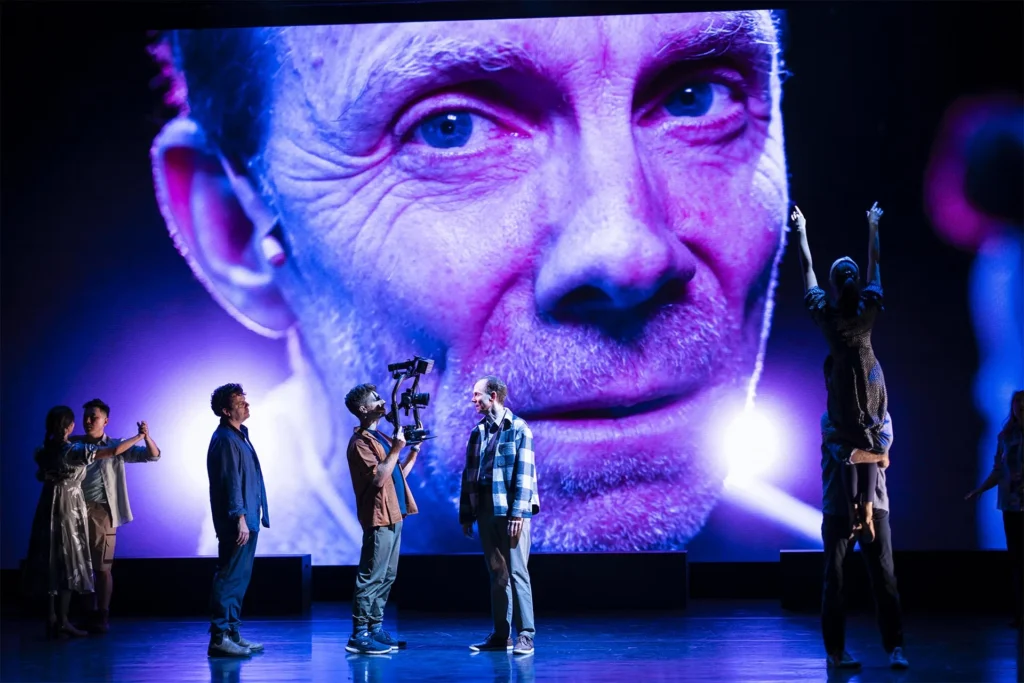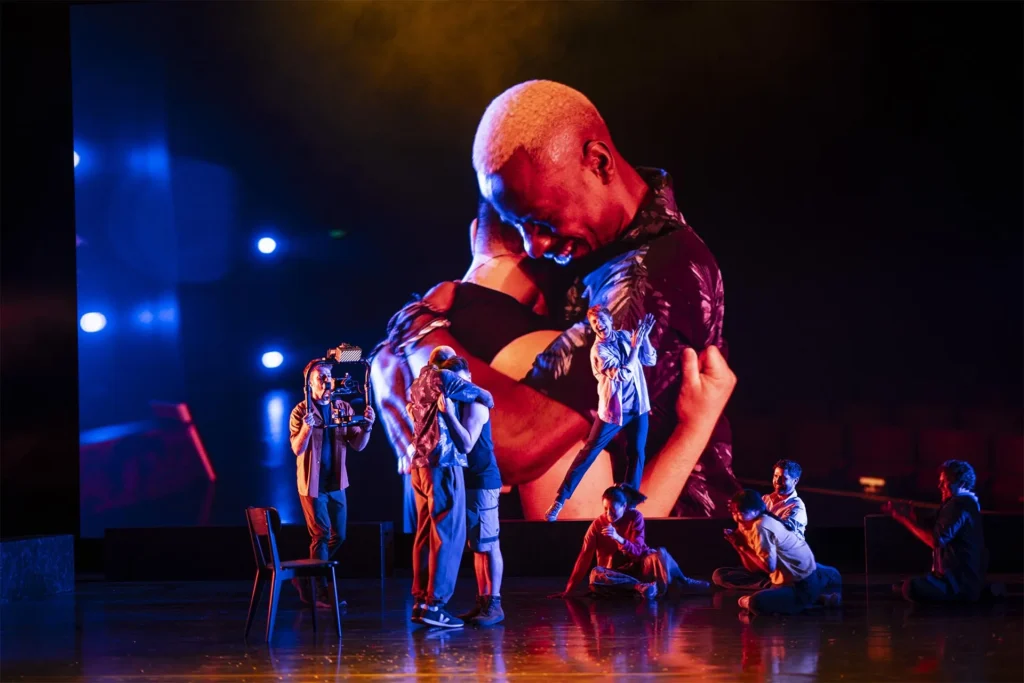Bringing Trent Dalton’s Love Stories to the stage demanded a video design that could match the profound tenderness, whimsy, and emotional expansiveness of Dalton’s writing. More than just a storytelling support, the video design needed to carry memory, imagination, and the sensation of falling into someone else’s story — or placing an audience in their shoes — evoking the deeply human heart at the centre of every interview and encounter Dalton captured.
 Production Photograph — Craig Wilkinson
Production Photograph — Craig Wilkinson
The design embraced a cinematic language that blurred reality, theatricality, and memory. It didn’t merely locate the audience in a minimal rendering of King George Square; instead, it drew viewers into emotional and psychological landscapes, creating an aperture through which they could connect with each individual’s story. Locations like King George Square appeared not as literal reproductions but as abstract, minimalistic impressions — blue sky and rolling clouds blanketing the urban environment. Similarly, the Husband’s home was rendered with an evocative hand — an aperture of a kitchen window or a bedhead — a visual shorthand for domesticity.
 Design Concept Render
Design Concept Render
Technically, the production was anchored by a large 10m x 4.5m LED screen that formed the visual backbone of the minimalist set. This scale allowed video to function both scenically and emotionally — capable of shifting between expansive cinematic sequences and intimate, textured imagery without ever overwhelming the live performers. Throughout the production, live camera work also played a key role in the storytelling language. Real-time video captured intimate moments of connection, enabling the audience to zoom in on subtle gestures and shifting emotions, enhancing the immediacy and intimacy of each story.

Production Photograph — Craig Wilkinson
Live camera created the writer’s point of view, giving audiences access to these stories on a deeply human level — in close-up — suspending time at a busy street corner and offering a glimpse into the soul. The kinetic energy of the camera was grounded in the movement work of the piece — fluid and always motivated — making the visible camera operator an integral part of the theatrical storytelling. An overhead PTZ camera was used to shift the audience’s perspective from intimate presence to a bird’s-eye view of pedestrian traffic in King George Square.
To honour the legacy of Trent Dalton collecting love stories on the corner of King George Square with his old sky-blue Olivetti typewriter, we extended that gesture into the design. We invited audiences to submit their own responses to the prompt “Love is…” online. During preshow, these submissions were overlayed onto a live camera feed pointed at the audience, extending the story beyond the proscenium. Submissions were updated for each performance so people could see their own contributions reflected.
 Production Photograph — David Kelly
Production Photograph — David Kelly
Generative content was created using NOTCH to heighten moments of memory. These included freeze frames of the live camera as we journeyed into a character’s vision of the future, expressed through contemporary movement. Particle effects were overlayed on the live feed to depict the Husband’s heightened dream state as he grappled with the complexities of his own love story.
Close collaboration with set and costume designer Renée Mulder and lighting designer Ben Hughes was essential, ensuring that video, light, and scenic design worked as one integrated vessel. Colour became a foundational emotional language throughout the work, especially during expressionistic movement sequences where emotion and physicality became more abstract and pure in form.
We also captured a number of the original storytellers in moving portraits, which were used during the final scene to honour the real people and stories shared, before journeying through a theatrical door back to King George Square — a gesture that invites the audience to continue writing their own love story.
 Production Photograph — David Kelly
Production Photograph — David Kelly
Ultimately, the goal was to create a visual language that honoured the real people and genuine emotions at the heart of Love Stories — crafting a stage world that audiences could slip into effortlessly, where the lines between lived memory and present experience blurred into one heartfelt, unforgettable moment.
Helping to design and visualise Love Stories was a profound creative privilege: an exercise in restraint, intuition, and deep emotional listening. I’m incredibly proud to have contributed to a production that celebrated love in all its fragile, messy, and magnificent forms.
Production trailer
See more about the production here.
